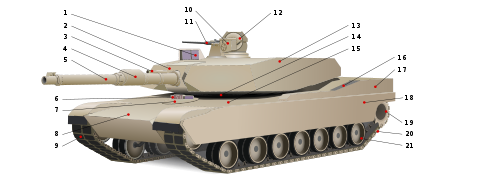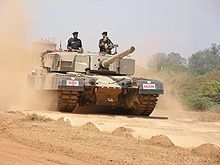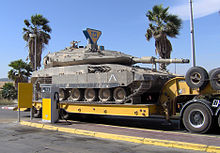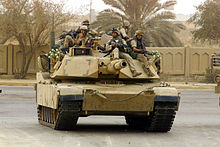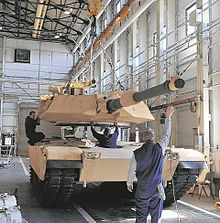- Main battle tank
-
"Battle Tank" redirects here. For the video game, see Battle Tank (video game).
Main battle tank 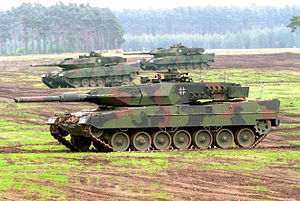
German Leopard 2A5 main battle tank.Type Tank Service history In service 1946–present Specifications Main
armamentTank gun Suspension Torsion bar or hydropneumatic. Time - World War I
- Interwar
- World War II
- Cold War Tanks
Place - United Kingdom
- China
- Germany
- Japan
- Russia
- Spain
- United States
A main battle tank (MBT), also known as a battle tank or universal tank, is a tank that fills the heavy direct fire role of many modern armies. They were originally conceived to replace the light, medium, heavy and super-heavy tanks. Development was spurred onwards in the Cold War with the development of lightweight composite armor. They are still supplemented in some armies with light tanks.
Today, main battle tanks are considered a key component of modern armies.[1] Modern MBTs seldom operate alone, as they are organized into armored units which involve the support of infantry, who may accompany the MBTs in infantry fighting vehicles. They are also often supported by surveillance or ground-attack aircraft.[2]
Contents
History
Cold War
 T-72B with thick "Dolly Parton" composite armor on the turret front.
T-72B with thick "Dolly Parton" composite armor on the turret front.
The concept of the medium tank gradually evolved into the MBT in the 1960's,[3] as it was realized that medium tanks could carry guns (such as the US 90 mm, Soviet 100 mm, and especially the British L7 105 mm) that could penetrate any practical level of armor at long range. The World War II concept of heavy tanks, armed with the most powerful guns and heaviest armor, became obsolete because they were as vulnerable as other vehicles to the new medium tanks.[citation needed] Likewise, World War II had shown that lightly armed and armored tanks were of limited value in most roles. Even reconnaissance vehicles had shown a trend towards heavier weight and greater firepower during World War II; speed was not a substitute for armor and firepower.
 XM1 Abrams in 1979.
XM1 Abrams in 1979.
An increasing variety of anti-tank weapons and the perceived threat of a nuclear war prioritized the need for additional armor. The additional armor prompted the design of even more powerful cannons.[4] The main battle tank thus took on the role the British had once called the 'Universal tank', exemplified by the Centurion, filling almost all battlefield roles. Typical main battle tanks were as well armed as any other vehicle on the battlefield, highly mobile, and well armored. Yet they were cheap enough to be built in large numbers. The first Soviet main battle tank was the T-64[5] and the first American MBT was the M60 Patton.[6]
The adoption of ceramic MBT armor as well as greater armor coverage necessitated by non-frontal attacks from combat helicopters also resulted in an effective counter to nuclear explosion radiation.[7]
By the late 70's MBT's were manufactured by France, West Germany, Britain, India, Japan, the USSR, Sweden, Switzerland, and the United States.[8]
The Soviet Union war doctrine depended very heavily on the MBT, so much so that any weapon advancement making the MBT obsolete could have severely devastated the Soviet Union's fighting capability.[9] The Soviet Union made advancements to the gun system. Mechanical autoloaders were introduced to replace the human loader. This permitted the turret to be reduced in size making the target smaller and less visible.[4] Missile systems were added to extend range of the gun and to enhance the first-round hit probability.[4]
Gulf War
Though the Gulf War reaffirmed the role of main battle tanks, MBT's were outperformed by the attack helicopter.[10] Other strategists asserted that the MBT was entirely obsolete because of the efficacy and speed that coalition forces neutralized Iraqi armor.[11]
Asymmetrical warfare
 A German Leopard 2 in the PSO-version, prepared for asymmetrical warfare
A German Leopard 2 in the PSO-version, prepared for asymmetrical warfare
As of 2005, there were 1,100 M1 Abrams used by the United States Army in the course of the Iraq War. They have proven to have an unexpectedly high vulnerability to roadside bombs.[12] A relatively new type of remotely-detonated mine, the explosively formed penetrator was used with some success against American armored vehicles. However, with upgrades to their rear armor, M1s have proven to be valuable in urban combat; at the Battle of Fallujah, the United States Marines brought in two extra brigades.[13] Britain deployed its Challenger 2 tanks to support its operations in southern Iraq.
Nations like Israel are reducing the size of their tank fleet and procuring more advanced models.[14]
Advanced armor has not improved vehicle survivability but has reduced crew fatalities.[15] Unmanned cupolas called remote weapon stations enhance crew survivability. Experimental tanks with unmanned turrets locate crewmembers in the heavily armored hull improving survivability and reducing the vehicle's profile.[16]
The obsolescence of the tank has been asserted from time-to-time but recent history suggests that the MBT's are still necessary.[17] Technology is reducing the weight and size of the modern MBT.[18] A British military document from 2001 indicated that the British Army would not procure a replacement for the Challenger 2 because of a lack of conventional threats in the foreseeable future.[19]
Design
Overview
- 1. Periscope
- 2. Gun mantlet
- 3. Coaxial gun
- 4. Bore evacuator
- 5. Main gun
- 6. Driver's optics
- 7. Driver's hatch
- 8. Glacis plate
- 9. Continuous track
- 10. Machine gun ammunition
- 11. Commander's machine gun
- 12. Hatch or cupola
- 13. Gun turret
- 14. Turret ring
- 15. Hull
- 16. Engine air intake
- 17. Engine compartment
- 18. Armored skirt
- 19. Drive sprocket
- 20. Link
- 21. Road wheel
Countermeasures
Originally, most MBTs relied on traditional steel armor to defend against various threats. As newer threats emerged, however, the defensive systems used by MBTs had to evolve to counter them. One of the first new developments was the use of Explosive reactive armor (ERA), developed by Israel in the early 1980s to defend against the shaped-charge warheads of modern anti-tank guided missiles and other such high-explosive anti-tank (HEAT) projectiles. This technology was subsequently adopted and expanded upon by the United States and Soviet Union.
MBT armor is concentrated at the front of the tank where it is layered up to a third of a meter thick.[20]
 The M1 Abrams has been modified to counter threats unique to asymmetric warfare.
The M1 Abrams has been modified to counter threats unique to asymmetric warfare.
Missiles are cheap and cost-effective anti-tank weapons.[21] ERA can be quickly added to vehicles to increase their survivability. The detonation of ERA blocks creates a hazard to supporting infantry near the tank. Despite this drawback, it is still employed on many Russian MBTs, the latest generation Kontakt-5 being capable of defeating both HEAT and kinetic energy penetrator threats. The Soviets also developed systems designed to more actively neutralize hostile projectiles before they could even strike the tank, namely the Shtora and Arena systems. Recently, the United States has adopted similar technologies in the form of the Missile Countermeasure Device and as part of the Tank Urban Survival Kit used on Abrams tanks serving in Iraq.
Other defensive developments focused on improving the strength of the armor itself; the most notable advancement coming from the British with the development of chobham armor in the 1970s. It was first employed on the American M1 Abrams and later the British Challenger 1. Chobham armor uses a lattice of composite and ceramic materials along with metal alloys to defeat incoming threats, and proved highly effective in the conflicts in Iraq in the early 1990s and 2000s; surviving numerous impacts from rocket-propelled grenades with negligible damage.
Weapons suite
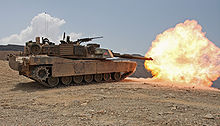 An M1 Abrams firing its main cannon.
An M1 Abrams firing its main cannon.
Main battle tanks are equipped with a main tank gun, and at least one machine gun.
MBT main guns are generally between 90 and 130 mm caliber, and can fire both anti-armor and, more recently, anti-personnel rounds. The cannon serves a dual role, able to engage other armored targets such as tanks and fortifications, and soft targets such as light vehicles and infantry. It is fixed to the turret, along with the loading and fire mechanism. Modern tanks utilize a sophisticated fire-control system, including rangefinders, computerized fire control, and stabilizers, which are designed to keep the cannon stable and aimed even if the hull is turning or shaking, making it easier for the operators to fire on the move and/or against moving targets. Gun-missile systems are complicated and have been particularly unsatisfactory to the United States who abandoned gun-missile projects such as the M60A2 and MBT-70.[22] The MBT's role could be compromised because of the increasing distances involved and the increased reliance on indirect fire.[16] The tank gun is still useful in urban combat for precisely delivering powerful fire while minimizing collateral damage.[11]
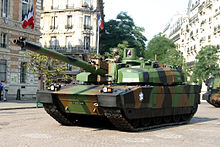 French Leclerc
French Leclerc
Tank guns can fire both anti-armor and, more recently, anti-personnel rounds, high explosive anti-tank (HEAT), and some form of high velocity kinetic energy penetrator, such as APFSDS (Armor-piercing fin stabilized discarding sabot) rounds are carried for anti-armor purposes. Anti-personnel rounds such as high explosive or high explosive fragmentation have dual purpose. Usually, a MBT carries 30-50 rounds of ammunition for its main gun, usually split between HE, HEAT and kinetic energy penetrator rounds. Some MBTs may also carry smoke or white phosphorus rounds. Some MBTs are equipped with an autoloader, such as the French Leclerc, or the Russian T-64, T-72, T-80 and T-90 and, for this reason, the crew is reduced to 3 members. MBTs with an autoloader require one less crew member and the autoloader requires less space than its human counterpart, allowing for a reduction in turret size.[23] This reduces the silhouette which improves the MBT's survivability.[24]
As secondary weapons, an MBT usually uses between two and four machine guns to engage infantry and light vehicles. Many MBTs mount one heavy caliber anti-aircraft machine gun (AAMG), usually of .50 caliber (like the M2 Browning or DShK), which can be used against helicopters and low flying aircraft. However, their effectiveness is limited in comparison to dedicated anti-aircraft artillery. The tank's machine guns are usually equipped with between 500 and 3000 rounds each.
Mobility
MBTs, like previous models of tanks, move on treads, which allow a decent level of mobility over most terrain including sand and mud. They also allow tanks to climb over most obstacles. MBTs can be made water-tight, so they can even dive into shallow water (5 meters with snorkel). However, treads are not as fast as wheels; the maximum speed of a tank is about 65 km/h (72 km/h for the M1 Abrams). The extreme weight of vehicles of this type (60-70 tons) also limits their speed. They are usually equipped with a 1200-1500 HP engine (more than 25,000 cc), with an operational range near 500 km.
The German Army has prioritized mobility in its Leopard 2 which is considered the fastest MBT in existence.[21]
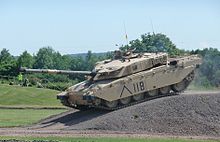 A former British Army Challenger 1
A former British Army Challenger 1
The MBT is often cumbersome in traffic, much to the disdain of drivers who must share the road with it. The tracks can damage some roads after repeated use. Many structures like bridges do not have the load capacity to support an MBT. In the fast pace of combat it is often impossible to test the sturdiness of these structures. In the 2003 invasion of Iraq, an M1 Abrams attempting to cross a bridge to evade enemy fire plummeted into the Euphrates river when the bridge collapsed.[11] Though appreciated for its excellent off-road characteristics, the MBT can become immobilized in muddy conditions.
The high cost of MBTs can be attributed in part to the high performance engine-transmission system. Also, propulsion systems are not produced in high enough quantities to take advantage of economies of scale.[25]
Crew fatigue limits the operational range of MBTs in combat. Reducing the crew to three and relocating all crewmembers from the turret to the hull could provide time to sleep for one off-shift crewmember located in the rear of the hull. In this scenario, crewmembers would rotate shifts regularly and all would require cross-training on all vehicle job functions.[26] Cargo aircraft are instrumental to the timely deployment of MBTs. The absence of sufficient numbers of strategic airlift assets can limit the rate of MBT deployments to the number of aircraft available.[27] The only aircraft capable of transporting full-featured MBTs with ease are the C-5 Galaxy, Antonov An-22, and Antonov An-124 which are declining in number. Military planners anticipate that the airlift capability for MBTs will not improve in the future.[28] To date, no helicopter has the capability to lift MBTs.[11] Rail and road are heavily used to move MBTs nearer to the battle, ready to fight in prime condition.[28] Where well maintained roads allow it, wheeled tank transporters can be used.[29]
The difficult task of resupply is usually accomplished with large trucks.[30]
Storage
Main battle tanks have internal and external storage space. Internal space is reserved for ammunition. External space enhances independence of logistics and can accommodate extra fuel and some personal equipment of the crew.[31]
The Israeli Merkava can even accommodate crewmembers displaced from a destroyed vehicle in its ammunition compartment.[26]
Crew
Emphasis is placed on selecting and training main battle tank crew-members. The crew must perform their tasks faultlessly and harmoniously so commanders select teams taking into consideration personalities and talents.[11]
Role
U.S. Marines ride an M1 Abrams.
The main battle tank fulfills the role the British had once called the 'universal tank', filling almost all battlefield roles. They were originally designed in the Cold War to combat other MBT's.[16] The modern light tank supplements the MBT in expeditionary roles and situations where all major threats have been neutralized and excess weight in armor and armament would only hinder mobility and cost more money to operate.
Reconnaissance by MBTs is performed in high-intensity conflicts where reconnaissance by light vehicles would be insufficient due to the necessity to 'fight' for information.[28]
In asymmetric warfare, main battle tanks are deployed in small highly concentrated units. MBTs fire only at targets at close range and instead rely on external support such as unmanned aircraft for long range combat.[32]
Main battle tanks have significantly varied characteristics. Procuring too many varieties can place a burden on tactics, training, support and maintenance.[33]
The MBT has a positive morale effect on the infantry it accompanies.[34] It also instills fear in the enemy who can often hear or even feel the arrival of MBTs.[11]
Procurement
Research and development
Manufacture
MBT production is increasingly being outsourced to wealthy nations. Tank manufacturers are primarily located in the northern hemisphere, whereas the major consumers are located in the Middle-East. Countries that are just beginning to produce tanks are having difficulties remaining profitable in an industry that is increasingly becoming more expensive through sophistication of technology. Even some large-scale producers are seeing declines in production. Even China is divesting many of its MBTs.[28]
The production of main battle tanks is limited to manufacturers that specialize in combat vehicles. Commercial manufacturers of civilian vehicles cannot easily be repurposed as MBT production facilities.[35]
Prices for MBTs have more than tripled from 1943–2011, but this pales in comparison with the price increase in fighter aircraft from 1943-1975.[16]
Marketing
Several MBT models, such as the AMX-40 and OF-40, were marketed almost solely as export vehicles.[28]
Several tank producers, such as Japan and Israel, choose not to market their creations for export.[28] Others have export control laws in place.
See also
References
- ^ House (1984), Toward Combined Arms Warfare:A Survey of 20th-Century Tactics, Doctrine, and Organization
- ^ Tranquiler, Roger, Modern Warfare. A French View of Counterinsurgency, trans. Daniel Lee, "Pitting a traditional combined armed force trained and equipped to defeat similar military organisations against insurgents reminds one of a pile driver attempting to crush a fly, indefatigably persisting in repeating its efforts."
- ^ Советская Военная Энциклопедия. Под ред. Гречко А.А. - М.: Воениздат, 1976-80 гг., в 8-и томах, статья «Танк» (Soviet Military Encyclopedia)
- ^ a b c Front Cover Thomas W. Zarzecki (2002). Arms diffusion: the spread of military innovations in the international system. Psychology Press. p. 212. ISBN 0-415-93514-8. http://books.google.com/books?id=fhnixhMQqW8C&dq=%22main+battle+tank%22&source=gbs_navlinks_s. Retrieved 5 April 2011.
- ^ T-64 manual ("Танк Т-64А. Техническое описание и инструкция по эксплуатации. 1984") state T-64 as "main battle" tank, while previous T-62 and T-55 (in corresponding military manuals, like "Танк Т-62. Руководство по материальной части и эксплуатации. 1968") stated as "medium" tanks
- ^ MIL-T-45308 state "Tank, Main Battle, 105MM Gun, M60", while MIL-T-45148 state "TANK, COMBAT, FULL-TRACKED, 90MM GUN, M48A2"
- ^ AcademicJohn Harris and Andre Gsponer (1986). Armour defuses the neutron bomb. Reed Business Information. p. 47. http://books.google.com/books?id=mYVNkaEJpz4C&pg=PA47&dq=%22main+battle+tank%22&hl=en&ei=aUEyTrr0Gun_sQL0i8HmCg&sa=X&oi=book_result&ct=result&resnum=4&ved=0CDcQ6AEwAzgo#v=onepage&q=%22main%20battle%20tank%22&f=false. Retrieved 29 July 2011.
- ^ Academic American encyclopedia , Volume 2 (1980). Academic American encyclopedia , Volume 2. Aretê Pub. Co., 1980. p. 177. http://books.google.com/books?id=_ZEJAAAAIAAJ&q=%22main+battle+tank%22&dq=%22main+battle+tank%22&hl=en&ei=IQyaTbOfGI-40QG9-6z-Cw&sa=X&oi=book_result&ct=result&resnum=5&ved=0CEAQ6AEwBDiOAg&safe=active. Retrieved 4 April 2011.
- ^ David C. Isby (1988). Weapons and tactics of the Soviet Army. Jane's. http://books.google.com/books?id=923fAAAAMAAJ&q=%22Main+battle+tank%22&dq=%22Main+battle+tank%22&hl=en&ei=ihaaTYv_G4HegQfKvcC6CA&sa=X&oi=book_result&ct=result&resnum=7&ved=0CEYQ6AEwBjjKAg&safe=active. Retrieved 4 April 2011.
- ^ Canadian Institute of Strategic Studies (1993). The Canadian strategic forecast. Canadian Institute of Strategic Studies. p. 73. http://books.google.com/books?id=-p8pAQAAIAAJ&q=%22main+battle+tank%22&dq=%22main+battle+tank%22&hl=en&ei=rPyZTcmxIaTh0gGOlrTlCw&sa=X&oi=book_result&ct=result&resnum=3&ved=0CDUQ6AEwAjiEAg&safe=active. Retrieved 4 April 2011.
- ^ a b c d e f Tools of violence: guns, tanks and dirty bombs. Osprey Publishing. 2008. http://books.google.com/books?id=K7kxs__WNU8C&dq=%22Main+battle+tank%22&source=gbs_navlinks_s. Retrieved 6 April 2011.
- ^ Komarow, Steven (2005-03-29). "Tanks take a beating in Iraq". Usatoday.Com. http://www.usatoday.com/news/world/iraq/2005-03-29-abrams-tank-a_x.htm. Retrieved 2010-04-09.
- ^ Komarow, Steven (2005-03-29). "Tanks adapted for urban fights they once avoided". Usatoday.Com. http://www.usatoday.com/news/world/2005-03-29-tank-inside_x.htm. Retrieved 2010-04-09.
- ^ Anthony H. Cordesman (2006). Arab-Israeli military forces in an era of asymmetric wars. Greenwood Publishing Group. ISBN 0-275-99186-5. http://books.google.com/books?id=3eZK7cm6pjoC&printsec=frontcover&source=gbs_ge_summary_r&cad=0#v=onepage&q&f=false. Retrieved 14 February 2011.
- ^ Israel and Syria: the military balance and prospects of war. ABC-CLIO. 2008. p. 99. ISBN 978-0-313-35520-2. http://books.google.com/books?id=PS2MEnlD7TAC&source=gbs_navlinks_s. Retrieved 1 April 2011.
- ^ a b c d Neville Brown (2009). The geography of human conflict: approaches to survival. Sussex Academic Press. p. 254. ISBN 978-1-84519-169-6. http://books.google.com/books?id=TJrQ1kq9TjEC&dq=%22Main+battle+tank%22&source=gbs_navlinks_s. Retrieved 5 April 2011.
- ^ Asia-Pacific defence reporter, Volume 30. Asia-Pacific Defence Publications. 2004. http://books.google.com/books?id=gEG6AAAAIAAJ&q=%22UK's+Challenger+11+were+indispensable+elements+in+the%22&dq=%22UK's+Challenger+11+were+indispensable+elements+in+the%22&hl=en&ei=GmGXTcXnGsTSgQfRjNmuCA&sa=X&oi=book_result&ct=result&resnum=1&ved=0CDEQ6AEwAA. Retrieved 2 April 2011.
- ^ Stan Krasnoff (2008). A Claytons Defense. Strategic Book Publishing. p. 35. http://books.google.com/books?id=A3U5otuf2hUC&dq=%22Main+battle+tank%22&source=gbs_navlinks_s. Retrieved 5 April 2011.
- ^ Gender, War, and Militarism: Feminist Perspectives. ABC-CLIO. 2010. pp. 40. ISBN 978-0-313-39143-9. http://books.google.com/books?id=om3yy1JoS34C&vq=isbn&dq=%22Main+battle+tank%22&source=gbs_navlinks_s. Retrieved 3 July 2011.
- ^ Avoiding nuclear war: common security as a strategy for the defence of the West. Brassey's Defence Publishers. 1985. p. 38. http://books.google.com/books?id=tDnfAAAAMAAJ&q=%22main+battle+tank%22&dq=%22main+battle+tank%22&hl=en&ei=rPyZTcmxIaTh0gGOlrTlCw&sa=X&oi=book_result&ct=result&resnum=1&ved=0CCwQ6AEwADiEAg&safe=active. Retrieved 4 April 2011.
- ^ a b The Oxford companion to military history. Oxford University Press. 2001. pp. 493, 902. http://books.google.com/books?id=ro8YAAAAIAAJ&q=%22main+battle+tank%22&dq=%22main+battle+tank%22&hl=en&ei=MQ6aTYLeIIiL0QHr_-WHDA&sa=X&oi=book_result&ct=result&resnum=4&ved=0CEUQ6AEwAziYAg&safe=active. Retrieved 4 April 2011.
- ^ African armed forces journal. Military Publications Ltd.. 1994. p. 10. http://www.google.com/search?hl=en&safe=off&client=firefox-a&rls=org.mozilla%3Aen-US%3Aofficial&tbs=bks%3A1&q=%22Recoil+was+vicious+to+the%22&aq=f&aqi=&aql=&oq=. Retrieved 4 April 2011.
- ^ Jeff Groman (1985). Weapons of War. Gallery Books. p. 126. http://books.google.com/books?ei=y7NeTdbpAsL3gAeJ773PDQ&ct=result&id=R7y9k9JfYqoC&dq=autoloader+Main+battle+tank&q=autoloader#search_anchor. Retrieved 18 February 2011.
- ^ Thomas W. Zarzecki (2002). Arms diffusion: the spread of military innovations in the international system. Psychology Press. http://books.google.com/books?id=fhnixhMQqW8C&source=gbs_navlinks_s. Retrieved 18 February 2011.
- ^ National Research Council (U.S.). Committee on Adiabatic Diesel Technology (1987). A review of the state of the art and projected technology of low heat rejection engines: a report. National Academies. p. 108. http://books.google.com/books?id=BWErAAAAYAAJ&dq=%22Main+battle+tank%22&source=gbs_navlinks_s. Retrieved 2 April 2011.
- ^ a b Robin Fletche (May 1995). "The Crewing and Configuration of the Future Main Battle Tank". ARMOR. https://www.knox.army.mil/center/ArmorMag/backissues/1990s/1995/Mj95/3fletch95.pdf. Retrieved 4 May 2011.
- ^ British defence: a blueprint for reform. Brasseys Defence. 1987. p. 126. http://books.google.com/books?id=vnHfAAAAMAAJ&q=%22A+main+battle+tank+is%22&dq=%22A+main+battle+tank+is%22&hl=en&ei=yC-ZTda5Ks650QGv2b3qCw&sa=X&oi=book_result&ct=result&resnum=8&ved=0CFoQ6AEwBw. Retrieved 4 April 2011.
- ^ a b c d e f Mary Kaldor, Basker Vashee, World Institute for Development Economics Research (1998). [Restructuring the Global Military Sector: The end of military Fordism Restructuring the Global Military Sector: The end of military Fordism]. Continuum International Publishing Group. p. 108. ISBN 1-85567-428-9. Restructuring the Global Military Sector: The end of military Fordism. Retrieved 4 April 2011.
- ^ Brian MacDonald (1997). Military spending in developing countries: how much is too much?. McGill-Queen's Press - MQUP. pp. 136. ISBN 0-88629-314-6. http://books.google.com/books?id=F9NEecs7ACIC&dq=%22Main+battle+tank%22&source=gbs_navlinks_s. Retrieved 2 April 2011.
- ^ Michael Green (2008). War Stories of the Tankers: American Armored Combat, 1918 to Today. Zenith Imprint. p. 281. ISBN 978-0-7603-3297-9. http://books.google.com/books?id=bEUduMN4u8gC&dq=%22A+main+battle+tank+is%22&source=gbs_navlinks_s. Retrieved 4 April 2011.
- ^ David Miller (2000). The illustrated directory of tanks of the world. Zenith Imprint. p. 384. ISBN 0-7603-0892-6. http://books.google.com/books?id=Es5Pxu8AGqcC&dq=%22A+main+battle+tank+is%22&source=gbs_navlinks_s. Retrieved 4 April 2011.
- ^ "New Designs Suit Tanks For Asymmetric War". The McGraw-Hill Companies, Inc.. 25. http://www.aviationweek.com/aw/generic/story_channel.jsp?channel=defense&id=news/dti/2011/04/01/DT_04_01_2011_p43-298025.xml&headline=New%20Designs%20Suit%20Tanks%20For%20Asymmetric%20War. Retrieved 3 May 2011.
- ^ Saudi Arabia Enters the Twenty-first Century: The military and international security dimensions. Greenwood Publishing Group. 2003. p. 140. http://books.google.com/books?id=CGEJvqjn-1MC&dq=%22Main+battle+tank%22&source=gbs_navlinks_s. Retrieved 1 April 2011.
- ^ Front Cover Stanley Sandler (2002). Ground warfare: an international encyclopedia, Volume 1. ABC-CLIO. p. 59. ISBN 1-57607-344-0. http://books.google.com/books?id=L_xxOM85bD8C&dq=%22main+battle+tank%22&source=gbs_navlinks_s. Retrieved 5 April 2011.
- ^ United States. Congress. House. Committee on Appropriations (1990). Department of Defense appropriations for 1991, Part 6. U. S. Govt. Print. Off.. http://books.google.com/books?id=PJEcAAAAMAAJ&q=%22Main+battle+tank+is+a%22&dq=%22Main+battle+tank+is+a%22&hl=en&ei=JleZTbryL6Oy0QGe1sWBDA&sa=X&oi=book_result&ct=result&resnum=7&ved=0CE4Q6AEwBjgK. Retrieved 4 April 2011.
Categories:- Main battle tanks
Wikimedia Foundation. 2010.

